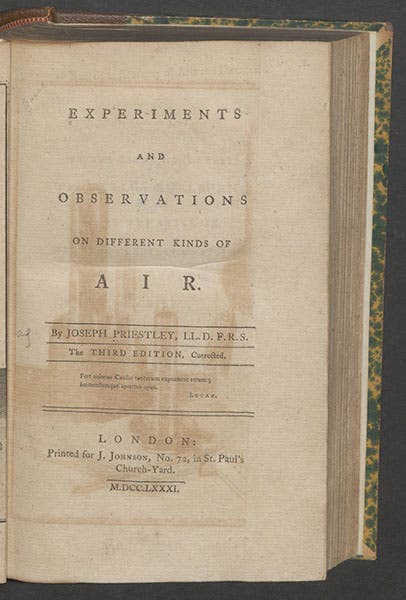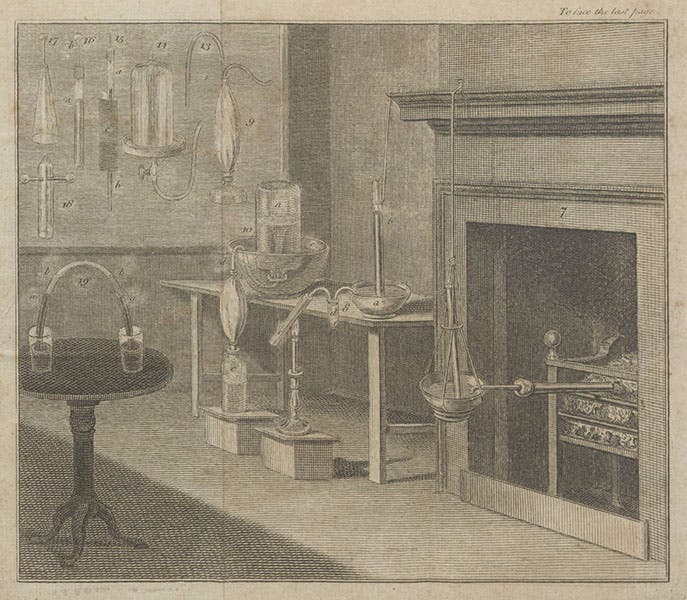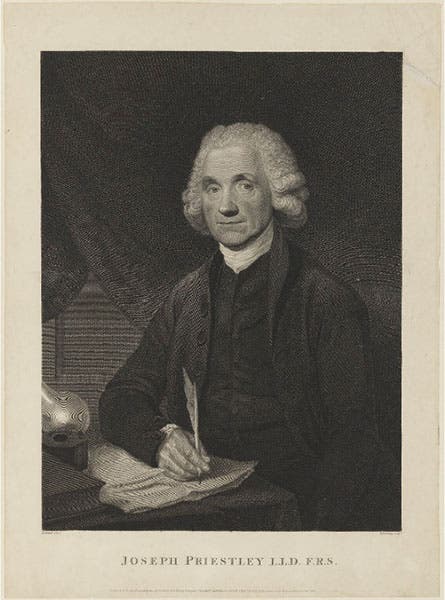Scientist of the Day - Joseph Priestley
Joseph Priestley, an English/American, chemist, religious dissenter, and political activist, was born Mar. 13, 1733. Priestley is best known for discovering oxygen in 1774, when he was living and teaching in Birmingham, England. He used a large lens to focus sunlight on a substance then known as red mercury (we now call it mercuric oxide) in a glass container inverted over a bath of metallic mercury. He found that a gas was given off that could be collected; it was much more supportive of combustion than ordinary air; a mouse could live in it 5 or 6 times longer than in ordinary air, and it felt really good to breathe. He later showed that ordinary air contains this new gas in a ratio of about 1:5.
Priestley called his new gas "dephlogisticated air," because Priestley subscribed to the phlogiston theory of combustion, according to which an object gives off a substance known as phlogiston when it burns, and a gas supports combustion to the extent that it can absorb phlogiston. Since his new gas could absorb great amounts of phlogiston, it must be almost completely "dephlogisticated". It was the Frenchman, Antoine Lavoisier , who (after Priestley told him about the new gas) made his own and called it oxygéne, and proposed a new theory of combustion whereby objects burn when they take on oxygen, not when they give off phlogiston. Priestley stuck to his phlogisticated guns until his death in 1804.
Priestley published an account of his work with gases, Experiments and Observations on Different Kinds of Air (1774-76), which contains an engraving of the “pneumatic trough” with which he collected his gases (second image). This picture is so superior to any other image of a pneumatic trough ever printed that it appears in nearly every history of chemistry and any other publication that mentions the trough, including Wikipedia’s article. We have a mixed edition of this 3-volume work (1777-1784) in our History of Science Collection, from which we have drawn several images here.
Priestley was a Unitarian from an early age, which means he was cut off from the Anglican academic establishment of Oxford and Cambridge and could only teach in dissenting academies. He was a great believer in personal liberty and equality, and he supported the American Revolution; when the French fomented their own revolution in 1789, he embraced that movement as well. This did not sit well with the English populace, and in 1791 (on the second anniversary of Bastille Day), Priestley's school and house in Birmingham were burned by a mob, and Priestley fled with his family, first to London, and then in 1794 to Philadelphia in the young American republic. Although he was welcomed by the Philadelphia intellectual community, he opted to move with his wife and sons to Northumberland, an ultra-rural community in east-central Pennsylvania, about 160 miles northwest of Philadelphia by road, and there he built a house and laboratory and pursued his scientific passions for the last 10 years of his life. His house still survives and is a National Historic Landmark and a National Historic Chemical Landmark, a place of pilgrimage for many American chemists interested in their historical roots. We discussed the burning of Priestley’s house and his move to the United States in an earlier post, where you can find images of the fire, of his Northumberland house, and a splendid portrait of Priestley by Rembrandt Peale. That portrait was the basis for a U.S. postage stamp, which we did not show earlier, so we include it here (fifth image)
Our opening portrait is a small pastel by Ellen Sharples that she drew while in the United States and that is now in the National Portrait Gallery in London (first image). She actually did two portraits – we prefer this one. Sharples is also of interest because in 1816, she was commissioned to paint the son and daughter of a prominent Shropshire physician, giving us our first glimpse of 7-year-old Charles Darwin and his sister Catherine.
Our other portrait of Priestley (sixth image) is an engraving. It seems to portray a much older man, but it was actually executed two years before Sharples’ pastel. It too resides in the National Portrait Gallery in London.
Dr. William B. Ashworth, Jr., Consultant for the History of Science, Linda Hall Library and Associate Professor emeritus, Department of History, University of Missouri-Kansas City. Comments or corrections are welcome; please direct to ashworthw@umkc.edu.











